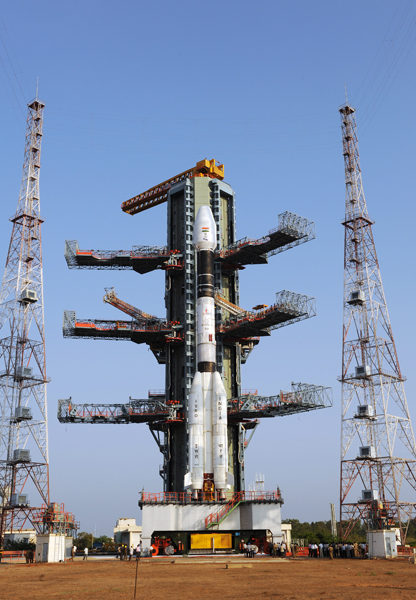Jason Davis • Jul 30, 2013
India prepares to return troubled rocket to flight
India is preparing for the return-to-flight of their Geosynchronous Satellite Launch Vehicle. The GSLV-D5 rocket, featuring an indigenously-developed upper stage engine, will loft a communications satellite into geosynchronous orbit. It is expected to be an important moment for the Indian Space Research Organisation, which has endured back-to-back failures of the GSLV. India's Economic Times reports the launch is scheduled for August 19 at 5:00 p.m. local time (11:30 UTC, 7:30 a.m. EDT).

Weighing in at two tons, the GSAT-14 satellite is too heavy for a ride on the workhorse Polar Satellite Launch Vehicle, which, despite its name, can also send payloads to geosynchronous orbit. Since its debut in 2001, the GSLV's third stage was powered by a Russian-built cryogenic engine. According to a 2010 article by Spaceflight Now, India purchased seven off-the-shelf engines to tide them over while they developed their own upper stage. Presumably, India's experience with the CUS will translate to the GSLV Mark III, an all-new rocket capable of lifting heavier payloads.
The new engine debuted April 15, 2010 on GSLV-D3, with the rocket flying under a Mark II moniker. Five minutes into flight, the second stage dropped away as scheduled, and the CUS ignited. It burned for a mere one-and-a-half seconds before the turbopump feeding liquid hydrogen to the engine's thrust chamber failed. Unpowered, the vehicle began to tumble. Its payload—an experimental communications satellite—splashed into the Bay of Bengal.
The next flight of the rocket took place several months later on December 25. For this mission, GSLV-F06, India went back to the Mark I version, using a slightly-upgraded third stage with a Russian-built engine.
The mission ended catastrophically, bringing the GSLV's success record to an abysmal four-out-of-seven. According to an ISRO failure report (PDF), the cause was "the untimely and inadvertent snapping of a group of 10 connectors located at the bottom portion of the Russian Cryogenic Stage. The premature snapping of these connectors has led to stoppage of [the] continuous flow of control commands to the First Stage control electronics." In other words, some critical electronic connectors broke, rendering the rocket unable to steer.

The GSLV was grounded for three years while engineers regrouped and made changes to the launch vehicle, including the CUS. The turbopump was modified and subjected to extensive testing.
"We have done nearly 35 ground tests since we had the April 2010 failure, on sub-systems, on the engine and on a similar engine in high altitude conditions," ISRO chief Dr. K. Radhakrishnan told the Economic Times. "We have to see [it] through. Stakes are very high, seriousness is very high. [The] entire organisation feels for it. For the last three years, we have been at it."
To a certain extent, the future of India's planetary science program rides on this launch. According to The Times of India, the Chandrayaan-2 moon mission—which features an orbiter, lander and rover—will launch on a GSLV. The Times quoted an unnamed ISRO official as saying, "We are now keeping our fingers crossed that the forthcoming mission should go off without a hitch. We are praying hard for its success."
The Time is Now.
As a Planetary Defender, you’re part of our mission to decrease the risk of Earth being hit by an asteroid or comet.
Donate Today

 Explore Worlds
Explore Worlds Find Life
Find Life Defend Earth
Defend Earth

